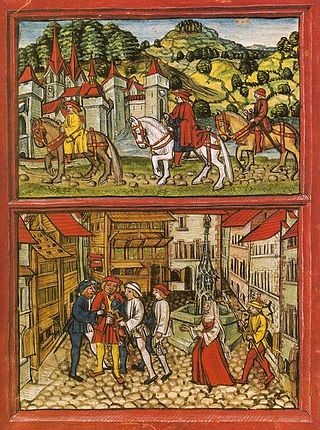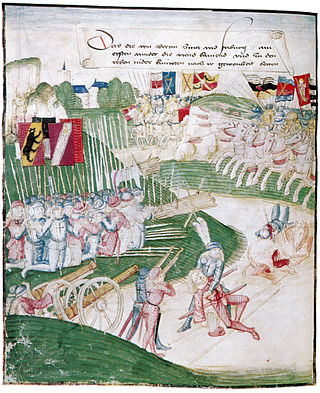
The Berner Schilling (or Amtliche Chronik, also Grosse Burgunderchronik, Great Burgundy chronicle) is a chronicle of Diebold Schilling the Elder of Bern (1480s), covering the history of the Old Swiss Confederacy up to the Burgundian Wars.

The Berner Schilling (or Amtliche Chronik, also Grosse Burgunderchronik, Great Burgundy chronicle) is a chronicle of Diebold Schilling the Elder of Bern (1480s), covering the history of the Old Swiss Confederacy up to the Burgundian Wars.

Arnold von Winkelried or Arnold Winkelried is a legendary hero of Swiss history. According to 16th-century Swiss historiography, Winkelried's sacrifice brought about the victory of the Old Swiss Confederacy in the Battle of Sempach (1386) over the army of the Habsburg Duke Leopold III of Austria.

Several illustrated chronicles were created in the Old Swiss Confederacy in the 15th and 16th centuries. They were luxurious illuminated manuscripts produced for the urban elite of Bern and Lucerne, and their copious detailed illustrations allow a unique insight into the politics and daily life of late medieval Switzerland on the eve of the Reformation. The most important of these chronicles are the works of the two Diebold Schillings, their luxurious execution, as well as their content reflecting the growing confidence and self-esteem of the leaders of the confederacy after their spectacular successes in the Burgundian Wars.

Diebold Schilling the Elder was the author of several of the Swiss illustrated chronicles, the Berner Schilling of 1483, the Zürcher Schilling of 1484, and the Spiezer Schilling (1480s).
The family of the two Swiss chroniclers called Diebold Schilling was originally from Solothurn. Klewi Schilling was a somewhat dubious character, and he was banned from the city, settling in Hagenau (Alsace), and probably died in Kaysersberg.

The Luzerner Schilling is an illuminated manuscript of 1513, containing the chronicle of the history of the Swiss Confederation written by Diebold Schilling the Younger of Lucerne.

Spiezer Schilling or Spiezer Chronik is a chronicle by Diebold Schilling the Elder of Bern (1480s), created after the Berner Schilling by the same author.

Valerius Anshelm, born as Valerius Rüd, was a Swiss chronicler working in Bern.

The Battle of Grandson was fought on 2 March 1476, during the Burgundian Wars, and resulted in a major defeat for Charles the Bold, Duke of Burgundy, at the hands of the Old Swiss Confederacy.

The Battle of Héricourt was fought on 13 November 1474 near Héricourt, Burgundy, as part of the Burgundian Wars. It resulted in victory for the Swiss Confederacy and its allies over the Burgundian State.

Adrian von Bubenberg was a Bernese knight, military commander and mayor (Schultheiss) of Bern in 1468-1469, 1473-1474 and 1477-1479. In Switzerland, he is remembered as the hero of the 1476 Battle of Murten.
Werner Schodoler (also Wernher Schodoler was a Swiss chronicler. He was the author of Swiss History, the earliest of the Swiss illustrated chronicles.

Hans Gieng was a Swiss Renaissance sculptor best known for his public fountain figures in the Old Town of Bern as well as Fribourg.
The Bernese Chronicle contains information about the early history of the city of Bern, Switzerland.

Berner Haselnusslebkuchen are Lebkuchen – traditional Christmas cakes – from Berne, Switzerland. Made from ground hazelnuts, they are not to be confused with the Berner Honiglebkuchen, another Bernese specialty.

Berner Honiglebkuchen are Lebkuchen traditionally made in Berne, Switzerland. Distinguished from other Lebkuchen by their sometimes elaborate sugar decorations, they are not to be confused with the Berner Haselnusslebkuchen, another Bernese specialty which is made from ground hazelnuts.

The Burgerbibliothek of Berne is a public library located at Münstergasse 63 in Berne, Switzerland.
The Schwabenkriegschroniken are a series of independent accounts written in Switzerland in or shortly after 1499 and recording the history of the war. The main texts are:

The Saubannerzug was a military campaign of irregular Swiss forces during the Fasnacht period of the year 1477, in the aftermath of the Battle of Nancy. It consisted of disgruntled men-at-arms from Central Switzerland who moved towards Geneva to enforce the payment of a sum of 24,000 Gulden owed to the Old Swiss Confederacy as ransom to escape looting.

Gerold Edlibach was a Swiss chronicler and official of Zurich, author of the Zürcher Chronik.
Johannes Fründ was a Swiss clerk and chronicler.